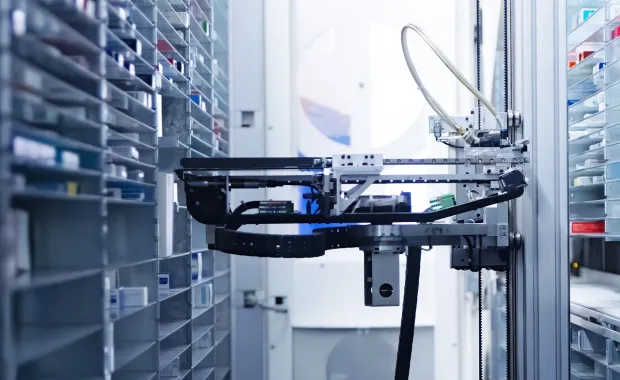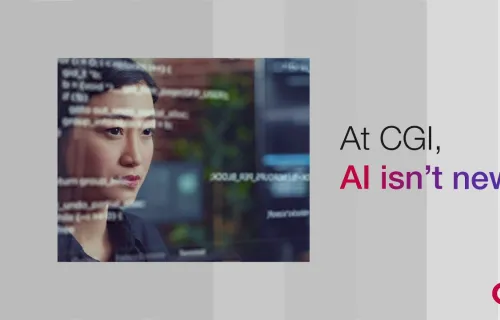Life sciences companies are no strangers to change, but the past several years have presented unprecedented challenges to the industry. As we’ve seen through the CGI Voice of our Clients interviews, the pandemic accelerated trends that were already underway, particularly digital transformation and increased customer- (or patient)-centricity. What's more, economic uncertainty has put pressure on the industry to do more with less while still delivering quality products and services.
Our clients are seeking new ways to remain competitive amidst turbulence. They're turning to emerging technologies, such as business process automation, to streamline operations, reduce costs, and focus resources on innovation and growth. I recently spoke with Mike Shafer, CGI's Vice-President of Business Consulting for Life Sciences, about automation in the life sciences industry, how it's transforming discovery, development, manufacturing and regulation, and ultimately helping get life-changing therapies into the hands of consumers faster.
Q: What are some key challenges our life sciences clients face post-pandemic?
A: COVID-19 created a major shift in consumer expectations around how quickly therapies and vaccines should become available. Biotech, pharma and medical device companies are under pressure to accelerate research and development and be the first to get new drugs to market.
At the same time, these companies face a complex regulatory environment with strict safety, efficacy and manufacturing quality requirements. So, the big challenge for the industry is balancing the need for speed and innovation with the need to ensure that new products are safe and effective for patients.
Another major issue right now is integration. In recent years, the industry has seen a wave of consolidation through mergers and acquisitions. The integration process can be highly complex given differences in culture, research and development pipelines and manufacturing processes. Companies are looking for ways to make this process more efficient.
Q: How can emerging digital technologies like automation and artificial intelligence (AI) help address these challenges?
A: The pandemic accelerated the shift to digital innovation across the board. When sites and offices were forced to shut down or at least minimize their physical presence, companies realized they could digitize many processes, particularly data capture, review and approval. In one specific example, digitizing lab results and providing secure, remote access to those results eliminates the need for 10 people to gather in a lab and transcribe, process, review or approve data. Only those performing the physical tests need to be there. That reduces risk as well as the need for office space.
You can see the clear benefits of automation in this scenario. By training bots against a clear set of data capture, calculation and workflow rules, as well as automatic notification specifications, companies can not only digitize and allow remote access to key workstreams but increase the speed and accuracy of the process. Plus, they free up their people to focus on higher-value activities.
Q: What are the challenges that come with implementing automation?
A: Some level of internal resistance is expected when adopting new digital processes and technologies. This is a risk-averse sector, and people tend to think that their processes are "too unique" for automation or that the risks to data security are too high. People felt the same about moving data to the cloud a few years ago. It was scary at first, and then it wasn't.
As a consultant, I spend a lot of time helping clients understand the benefits of automation and how it can apply to their existing processes. Once they see how it can streamline certain areas and even strengthen data integrity—as well as see proof that it can meet computer systems validation (CSV) and assurance principles in the good ‘x’ practice (GxP) space—the resistance subsides.
The flip side of this coin is that sometimes people expect automation to solve everything. In some cases, patterns or repeatable processes aren't there, no matter how much data you have. In these cases, even intelligent automation is not a viable solution. While it can be frustrating to reach this conclusion, you probably uncovered some key process areas that can be optimized in other ways.
Q: Beyond improving back-end processes, what role do you see automation playing a few years from now?
A: One area where I see automation making a big impact is the electronic common technical document or eCTD. It's the standard format required by global health authorities when submitting information for registration and approval of pharmaceuticals and biologics.
The eCTD pulls in data generated by different groups at different times over the drug development life cycle. Pulling it together is a laborious process. Automation could help in a myriad of ways. I can imagine a future-state scenario where intelligent automation bridges the gap between functions and content management systems to extract and format the necessary data and content, automatically creating draft versions of the eCTD and monitoring for changes in the source systems to make version-controlled updates.
Even before we reach that ideal state, we can make a lot of incremental gains with AI: automating sub-processes, identifying missing data, performing quality control checks and so on. Ultimately, if we accelerate the data-gathering process while reducing errors, we'll get faster approval from the authorities and faster delivery of approved medications to patients.
Q: How can CGI help life sciences clients accelerate their adoption of automation?
A: As one of the veterans in this space, we've had time to develop, validate and deploy a wide array of automation solutions for life sciences clients. We now operate what we call a "factory" model, with a library of intelligent automation processes that can be deployed quickly with slight variations based on client needs. This gives clients a menu to choose from versus being obligated to adopt an entire platform.
Our strategic partnerships are also a key differentiator. By collaborating with companies like UiPath, we can offer automation-as-a-service solutions such as CGI Accel360. Smaller firms or those not yet ready to invest in internal automation infrastructure can access the advantages of a hosted solution—including high levels of security, support, maintenance, and scalability. They can begin to enjoy the benefits of automation immediately, leading to a faster return on investment. And these automation solutions are transferrable should they decide to invest in internal AI capabilities down the line.
Q: How can you measure the value of automation?
A: The most obvious success measures are increased productivity and improved accuracy. Automation reduces errors and inconsistencies in data entry, workflow execution, manufacturing, and quality control—and that all adds up to faster time to market and healthier patients.
Learn more about our automation solutions for life sciences.





